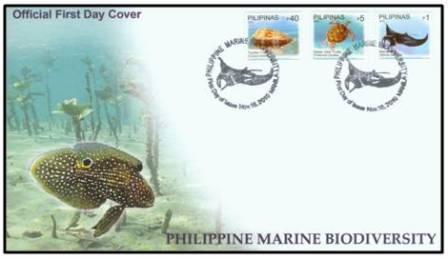2010, November 18. Philippine Marine Biodiversity - Definitives
Litho Offset. Amstar Company, Inc. Perf. 13.5
Singles, Sheets of 100 (10 x 10)
1p Manta Ray - Singles (4,660,000)
5p Green Sea Turtle - Singles (4,000,000)
40p Textile Cone - Singles (6,000,000)
Design Coordinators: Victorino Z. Serevo; Elenita D.L. San Diego
Source: Coral Reef Animals of the Indo-Pacific by Dr. Terence Gosliner
First Day Covers: Manila
MANTA RAYS. Largest rays and are closely related to sharks. These harmless rays have a short tail and no stinging spine. They are very acrobatic; they can even leap from the water. Remoras (Echeneida) are frequently seen with mantas, staying near the manta's mouth (even inside the gill cavities). The remoras probably feed on parasites on the manta's body and eat bits of the manta's food. (http://www.enchantedlearning.com/subjects/sharks/rays/Mantaray.shtml)
(Rays are a type of flattened fish and are closely related to sharks. Rays evolved from sharks. These social animals live in seas all over the world, and even in some estuaries. Rays often congregate in huge groups of up to thousands of individuals, but other rays live alone. Unlike other fish, rays and sharks have no bones; their skeleton is made of cartilage, which is a tough, fibrous substance, not nearly as hard as bone.)
CHELONIA MYDAS. Known as the Green sea turtle, is a large sea turtle belonging to the family Cheloniidae. It is the only species in the genus Chelonia. Its range extends throughout tropical and subtropical seas around the world, with two distinct populations in the Atlantic and Pacific Oceans. Their common name derives from the usually green fat found beneath their carapace (upper shell). The Green Sea Turtle is a sea turtle, possessing a dorsoventrally flattened body covered by a large, teardrop-shaped carapace and a pair of large, paddle-like flippers. It is usually lightly colored, although parts of the carapace can be almost black in the Eastern Pacific. Unlike other members of its family such as the Hawksbill Sea Turtle and Loggerhead Sea Turtle, Chelonia mydas is mostly herbivorous. The adults commonly inhabit shallow lagoons, feeding mostly on various species of seagrass. Like other sea turtles, they migrate long distances between feeding grounds and hatching beaches. Many islands worldwide are known as Turtle Island due to Green Sea Turtles nesting on their beaches. Females crawl out on beaches, dig nests and lay eggs during the night. Later, hatchlings emerge and walk into the water. Those that reach maturity may live to age 80 in the wild. (http://en.wikipedia.org/wiki/Green_turtle)
CONUS TEXTILE. Common name the Cloth of Gold cone is a venomous species of sea snail, a marine gastropod mollusk in the family Conidae, the cone snails, cone shells or cones. Typical length of adults is about 9 cm to 10 cm (3.5 in to 3.9 in). The maximum shell length for this species is 15 cm (5.9 in). The color pattern of its shell resembles a cellular automaton named rule 30. The female lays several hundred eggs at a time, which hatch after about 16 or 17 days. After hatching, the larvae float around in the current for approximately 16 days. Afterward, they settle at the bottom of the ocean. By this point their length is about 1.5 mm (0.06 in). (http://en.wikipedia.org/wiki/Conus_textile)
-
Marine Biodiversity
-
Marine Life

